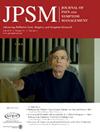不披露诊断对癌症患者死亡质量的影响:一项丧亲研究。
IF 3.2
2区 医学
Q2 CLINICAL NEUROLOGY
引用次数: 0
摘要
背景:为了患者的自主权和共同决策,患者应充分了解自己的病情。然而,在以家庭自主为导向的日本传统文化中,不向患者透露诊断结果的现象十分普遍。关于未告知诊断结果的患者的死亡质量(QOD)和护理质量(QOC)的研究尚不充分:本研究旨在探讨未告知诊断结果对癌症患者死亡质量(QOD)和护理质量(QOC)的影响:我们对一项横断面的全国死亡率跟踪调查进行了二次分析。遗属对问卷进行了回答。测量包括死者的 QOC、QOD 和遗属的结果。根据可能影响不披露行为的协变量,我们采用倾向得分匹配法对 "披露 "组和 "不披露 "组进行了比较,然后比较了两组间 QOC、QOD 和丧属结果的差异:在发出问卷的 110,990 位家庭成员中,我们最终分析了 46,672 份回复。披露组和非披露组分别包括 42,300 名(90.6%)和 4,372 名(9.4%)死者。与未披露组相比,披露组的大部分 QOD 领域(14/18)得分明显较高。就 QOC 领域而言,披露组在所有领域的得分都较高。披露组受访者对护理服务的总体满意度更高:我们的研究表明,在明确诊断为癌症的遗属中,癌症遗属的总体 QOD 和 QOC 明显更高。此外,在明确诊断为癌症的死者家属中,遗属的结局更好。本文章由计算机程序翻译,如有差异,请以英文原文为准。
Impact of Diagnosis Nondisclosure on Quality of Dying in Cancer Patients: A Bereavement Study
Context
Patients should be optimally informed about their illness for patients’ autonomy and shared decision-making. However, diagnosis nondisclosure to patients is traditionally widespread in Japanese culture with family-oriented autonomy. There is insufficient research on quality of death (QOD) and quality of care (QOC) among patients who are not told their diagnosis.
Objectives
This study aimed to examine the impact of diagnosis nondisclosure on QOD and QOC in cancer patients.
Methods
We performed a secondary analysis of a cross-sectional, nationwide mortality follow-back survey. The bereaved families responded to the questionnaire. Measurements included decedents’ QOC, QOD, and bereaved families’ outcomes. After using the propensity score matching method based on the covariates which can affect nondisclosure actions to compare the “disclosure” group and “nondisclosure” group, we compared differences in QOC, QOD, and bereaved families’ outcomes between the two groups.
Results
Of the 110,990 family members who were sent the questionnaires, we finally analyzed 46,672 responses. The disclosure group and nondisclosure group included 42,300 (90.6%) and 4,372 (9.4%) decedents, respectively. Most of the QOD domains (14/18) showed significantly higher scores in the disclosure group compared with the nondisclosure group. In terms of QOC domains, all domains showed higher scores in the disclosure group. Respondents in the disclosure group reported higher overall care satisfaction.
Conclusion
We demonstrated that overall QOD and QOC in decedents with cancer were significantly higher in decedents with explicit cancer diagnoses. Furthermore, bereaved family members’ outcomes were better among the family members of decedents with an explicit cancer diagnosis.
求助全文
通过发布文献求助,成功后即可免费获取论文全文。
去求助
来源期刊
CiteScore
8.90
自引率
6.40%
发文量
821
审稿时长
26 days
期刊介绍:
The Journal of Pain and Symptom Management is an internationally respected, peer-reviewed journal and serves an interdisciplinary audience of professionals by providing a forum for the publication of the latest clinical research and best practices related to the relief of illness burden among patients afflicted with serious or life-threatening illness.

 求助内容:
求助内容: 应助结果提醒方式:
应助结果提醒方式:


